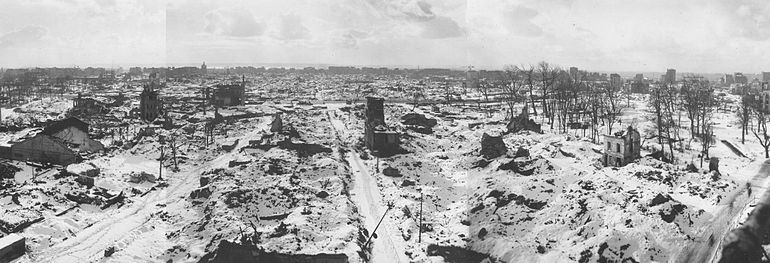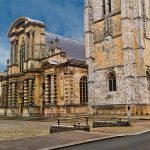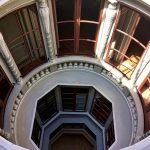Le Havre, founded in 1517 by King Francois I, is a coastal city on the west of France, in the Normandy region. It is France’s 2nd largest harbour (after Marseille) and Europe’s 5th biggest in terms of container ship movements.
Apart from the container ships, there are many oil and gas tankers, cruise ships and multiple daily ferries to the UK.

Le Havre is now a city with some 175,000 inhabitants, an international airport, harbour, motorway and railway station connecting it mainly to Paris and Marseille.
WWII and Rebuilding

Le Havre was almost totally destroyed during the second World War, not by the Germans but by the Allies since the Germans had made Le Havre into a major military and naval base. A large part of the city was blasted out of existence, the harbour was totally destroyed and the city had very few buildings left standing.
In 1945 the famous architect Auguste Perret was commissioned to rebuild Le Havre. Between 1945 and 1964, he and a team of some 50 architects rebuild the city with in their minds, a city with a lot of space, parks and water.

Using precast concrete blocks, Perret was able to quickly rebuild the city. The apartment buildings look alike, but are all different in some shape or form. The Perret style includes straight lines, narrow but tall, ceiling-to-floor, windows and ledges. The general style of Le Havre earned it a Heritage Site status of United Nations’ UNESCO in 2005.
Perret and his colleagues designed a new look for the city, and that not only involved making new housing. The city hall was completely rebuilt, parks were added and roads were widened.

Oscar Niemeyer Volcan
But it was not only the famous Auguste Perret who worked in the city. His more famous Brazilian colleague, Oscar Niemeyer (famous for designing many of the buildings in the Brazilian capital Brasilia, but also the UN building in New York and many others) created Le Havre’s concert hall, called the Volcano (you can see why from the photo).

Le Havre Structure
Le Havre has on the West the English channel, port and beach. In the South you can find part of the harbour and the industrial part, mostly the oil refineries and recently a large factory to build offshore windmills. Entry into the city is mostly done via the East, via the A13 motorway coming Rouen/Paris/Caen and the railway. The North is where you will find most of the suburbs and the international airport.

On the water side of Le Havre is the beach area. Like most beaches in Upper Normandy (above the Seine river), they are made out of pebbles, not sand. There is a very long promenade, restaurants (only during the extended summer months), skatepark and many summer beach huts.
For people who like walking, you can start at the harbour side (close to the Ferry terminal) and walk all the way alongside the sea, through the next city (St. Adresse) right until the promenade stops under the cliffs.
The Churches
There are 20 catholic churches and chapels in Le Havre, including the Notre-Dame Cathedral and the very modern but inspiring St. Joseph Church.
Notre-Dame de la Victoire et de la Paix Church
One church has a special feature not known to many:

It is a full size and exact replica of the Lourdes cave that has allegedly cured many sick people. This replica is quite popular with the people-in-the-know. So much so that a whole structure has been built around it.

The “Lourdes” grotto is to be found behind this church, Notre-Dame de la Victoire et de la Paix (built in 1924), located in the industrial area of Le Havre.
St. Vincent-de-Paul church
Another interesting church, one listed in the national monuments list of France, is the St. Vincent-de-Paul church located close to the beach area.

The church was built in 1849 but heavily destroyed during WWII. Here’s a 360° look inside the church (to see the 360°, click on the photo below, keep your mouse clicked and move up/down/left/right).
GR21
For the long distance hikers, Le Havre is the starting point of the GR21 hiking path. For some 180 kms, the GR21 path takes you mostly via the cliffs to Le Treport (North). It’s quite intense, since the cliffs can be steep. Along the way are many small hotels and restaurants, and the path takes you through many of the coastal towns.
Le Havre and the Artists
Le Havre has always been a favorite place for painters (and photographers), thanks to an abundance of objects to paint, and an incredible good light, giving a myriad of colours.
Many famous painters came here to paint, including will known names like Claude Monet, Eugene Boudin, Paul Renoir, Henri Matisse and many many others.
Here are the painters/artists who painted in Le Havre (a “*” indicates that the artist did not worked directly in Le Havre itself, instead worked closeby, a link “⇠” to the artist’s works will appear below when published):
- 🇫🇷 Adam, Edouard Marie ⇠
- 🇷🇺 Beggrov, Alexander ⇠
- 🇫🇷 Binet, George ⇠
- 🇺🇸 Boggs, Frank Myers ⇠
- 🇷🇺 Bogoliubo, Alexei ⇠
- 🇬🇧 Bonington, Richard Parkes ⇠
- 🇫🇷 Boudin, Eugene-Louis ⇠
- 🇫🇷 Braque, Georges ⇠
- 🇫🇷 Bruelle, Gaston ⇠
- 🇬🇧 Callow, William ⇠
- 🇬🇧 Cameron, David Young ⇠
- 🇫🇷 Ciceri, Eugene * ⇠
- 🇫🇷 Coignet, Jules ⇠
- 🇫🇷 Corot, Jean-Baptiste Camille ⇠
- 🇬🇧 Cotman, John Sell ⇠
- 🇬🇧 Cooke, Edward William ⇠
- 🇫🇷 Crepin, Louis-Philippe ⇠
- 🇫🇷 Cyr, Georges Albert ⇠
- 🇫🇷 Dauzats, Adrien * ⇠
- 🇫🇷 de Saint-Delis, Henri ⇠
- 🇫🇷 de Saint-Delis, Rene ⇠
- 🇳🇱 Dommersen, William ⇠
- 🇫🇷 Dubourg, Louis-Alexandre ⇠
- 🇫🇷 Dufy, Jean ⇠
- 🇫🇷 Dufy, Raoul ⇠
- 🇫🇷 Friesz, Othon ⇠
- 🇫🇷 Garneray, Ambroise Louis ⇠
- 🇫🇷 Gernez, Paul-Elie ⇠
- 🇫🇷 Goeneutte, Norbert ⇠
- 🇷🇺 Gritsenko, Nikolai ⇠
- 🇫🇷 Gudin, Theodore ⇠
- 🇫🇷 Guerard, Henri ⇠
- 🇫🇷 Guillaumin, Armand * ⇠
- 🇫🇷 Hervier, Louis ⇠
- 🇬🇧 Holland, James ⇠
- 🇫🇷 Huet, Paul ⇠
- 🇳🇱 Jongkind, Johan Barthold ⇠
- 🇬🇧 Kay, James ⇠
- 🇳🇱 Le Gray, Gustave ⇠
- 🇳🇱 Le Sidaner, Henri * ⇠
- 🇫🇷 Lebourg, Albert ⇠
- 🇬🇧 Lee-Hankey, William ⇠
- 🇫🇷 Lepoittevin, Eugene ⇠
- 🇫🇷 Leprince, Auguste-Xavier ⇠
- 🇫🇷 Letellier, Emile-Andre ⇠
- 🇫🇷 Loir, Luigi ⇠
- 🇫🇷 Loiseau, Gustave ⇠
- 🇫🇷 Luce, Maximilien ⇠
- 🇫🇷 Madelain, Gustave ⇠
- 🇫🇷 Marquet, Albert ⇠
- 🇫🇷 Maufra, Maxime ⇠
- 🇫🇷 Maze, Paul ⇠
- 🇫🇷 Monet, Claude ⇠
- 🇨🇦 Morrice, James Wilson ⇠
- 🇫🇷 Mozin, Charles-Louis ⇠
- 🇫🇷 Noel, Alexandre Jean ⇠
- 🇫🇷 Noel, Jules Achille ⇠
- 🇸🇪 Osslund, Helmer ⇠
- 🇫🇷 Pecrus, Charles Francois ⇠
- 🇫🇷 Petitjean, Edmond Marie ⇠
- 🇩🇰 Pissarro, Camille ⇠
- 🇫🇷 Pissarro, Lucien * ⇠
- 🇬🇧 Prout, Samuel * ⇠
- 🇫🇷 Robert, Hubert ⇠
- 🇫🇷 Roullet, Gaston ⇠
- 🇫🇷 Signac, Paul ⇠
- 🇬🇧 Stanfield, Clarkson Frederick ⇠
- 🇧🇪 Stevens, Alfred Emile Leopold ⇠
- 🇳🇱 Ten Cate, Siebe Johannes ⇠
- 🇳🇴 Thaulow, Fritz ⇠
- 🇫🇷 Thornley, Georges William ⇠
- 🇬🇧 Turner, Joseph Mallord William ⇠
- 🇨🇭 Vallotton, Felix ⇠
- 🇬🇧 Wadsworth, Edward ⇠
Related Posts
- 10000
- 10000
- 10000
- 10000
- 10000
 The recently (in 1974) appointed cathedral of Le Havre, the "Cathedrale Notre-Dame du Havre", is nothing to write home about. Outside it is interesting, but inside it's pretty drab. Its only saving grace is that it has an incredibly beautiful and imposing organ. It is also the oldest structure in Le Havre…
The recently (in 1974) appointed cathedral of Le Havre, the "Cathedrale Notre-Dame du Havre", is nothing to write home about. Outside it is interesting, but inside it's pretty drab. Its only saving grace is that it has an incredibly beautiful and imposing organ. It is also the oldest structure in Le Havre…




